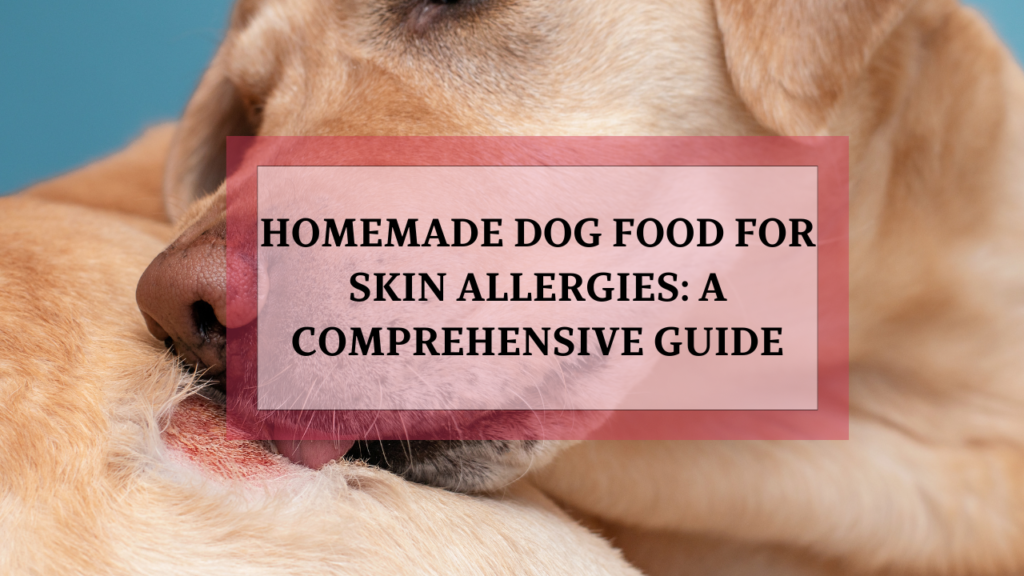If your dog is constantly scratching, has red or flaky skin, or suffers from hair loss, they might be dealing with skin allergies. Skin issues in dogs are often caused by food sensitivities, environmental factors, or underlying health conditions. While commercial dog foods claim to be “hypoallergenic,” many still contain common allergens like chicken, beef, wheat, and artificial preservatives that can trigger allergic reactions.
One of the best ways to help your dog find relief is by switching to a homemade diet tailored for dogs with skin allergies. By making your own dog food, you have full control over the ingredients, ensuring that your pup gets a nutritious, allergy-friendly meal. A well-balanced homemade diet can reduce inflammation, improve coat health, and eliminate common allergens that may be causing skin problems. Some owners also include omega-3 supplements to further support skin healing.
What You’ll Learn in This Guide
✅ The causes and symptoms of skin allergies in dogs
✅ How diet impacts skin health and allergy management
✅ The best ingredients for homemade dog food for skin allergies
✅ Vet-approved recipes to nourish your dog’s skin
✅ Essential nutrients and supplements to promote healing — such as probiotics and digestive support chews
✅ Step-by-step guide on transitioning to a homemade diet
By the end of this guide, you’ll have all the knowledge you need to create homemade dog food for skin allergies that is safe, nutritious, and free from allergens. Let’s get started!
How Diet Affects Skin Health and Allergies in Dogs
A dog’s skin and coat health are directly linked to their diet. The food your dog eats provides essential nutrients that support skin regeneration, reduce inflammation, and strengthen the immune system. When dogs consume allergenic or low-quality ingredients, their skin barrier weakens, making them more prone to itchiness, dryness, and infections.
The Role of Nutrition in Skin Health
Certain nutrients play a critical role in maintaining healthy skin and reducing allergic reactions. Including them in your dog’s diet can make a visible difference:
| Nutrient | Benefit | Best Sources |
|---|---|---|
| Omega-3 Fatty Acids | Reduce inflammation, improve coat shine | Salmon, sardines, flaxseeds, fish oil — many owners also add fish oil supplements for consistent results |
| Omega-6 Fatty Acids | Strengthen skin barrier, reduce dryness | Sunflower oil, chicken fat, evening primrose oil |
| Zinc | Supports immune function, heals wounds | Pumpkin seeds, beef, eggs |
| Vitamin E | Antioxidant that protects skin cells | Spinach, almonds, sunflower seeds |
| Biotin | Prevents dry, flaky skin, promotes hair growth | Eggs, sweet potatoes, liver |
| Probiotics | Improve gut health, reduce immune overreaction | Yogurt, kefir, fermented vegetables — or probiotic chews for daily support |
For more natural ways to manage itching, see our guide on dog treats for itchy skin.
Why Commercial Dog Food Can Worsen Allergies
Most commercial dog foods—even those labeled as “hypoallergenic” or “grain-free”—contain hidden allergens, artificial additives, and inflammatory ingredients that can worsen skin conditions.
🔴 Common Problematic Ingredients in Commercial Dog Food:
- ❌ Chicken and Beef – Two of the most common allergenic proteins for dogs.
- ❌ Grains (Wheat, Corn, Soy) – Many dogs have grain intolerances that cause skin inflammation.
- ❌ Artificial Preservatives & Colors – Chemicals like BHA, BHT, and ethoxyquin can trigger allergic reactions.
- ❌ Dairy Products – Many dogs are lactose intolerant, leading to itchiness and digestive issues.
By preparing homemade dog food for skin allergies, you eliminate these harmful ingredients and provide clean, nutrient-rich meals tailored to your dog’s needs. Some pet parents also include allergy-friendly treats to complement the diet without irritating the skin.
Best Homemade Dog Food Recipes for Skin Allergies
Making homemade dog food for skin allergies ensures your pup gets the best nutrients while avoiding common allergens. Below are four nutritious recipes that promote healthy skin, reduce itching, and improve coat quality.
1. Simple Homemade Dog Food Recipe (Salmon and Sweet Potato)
Salmon is packed with Omega-3 fatty acids, which help reduce inflammation, soothe itchy skin, and promote a healthy coat. Sweet potatoes are also one of the best ingredients for homemade dog treats, providing fiber, vitamins, and antioxidants, making this recipe perfect for dogs with sensitive skin. Some pet owners also add salmon oil to boost Omega-3 levels even further.
Ingredients:
✔ 1 lb salmon (boneless, skinless)
✔ 1 cup sweet potatoes (mashed)
✔ 1/2 cup green beans (chopped)
✔ 1/2 cup carrots (chopped)
✔ 1 tbsp flaxseed oil (for Omega-3s)
✔ 1/4 tsp turmeric powder (anti-inflammatory, also used in turmeric dog treats)
Step-by-Step Instructions:
- Bake the Salmon – Preheat the oven to 375°F (190°C) and bake salmon for 15–20 minutes until fully cooked. Let it cool and flake into small pieces.
- Cook the Sweet Potatoes – Peel, chop, and boil until soft, then mash them.
- Steam the Vegetables – Lightly steam green beans and carrots to retain nutrients.
- Combine Ingredients – Mix salmon, mashed sweet potatoes, and vegetables in a large bowl.
- Add Flaxseed Oil & Turmeric – Stir well to evenly distribute nutrients.
Storage and Serving Tips:
Store in an airtight container in the fridge for up to 3 days. For longer storage, freeze portions (up to 2 months). To keep mealtimes interesting, rotate with other homemade dog food recipes.
Serve at room temperature, around 1/2 to 1 cup per meal, depending on your dog’s size. Some owners also keep silicone dog food storage trays handy to make portioning easier.
2. Turkey and Pumpkin Allergy-Friendly Dog Food
Turkey is a lean protein that is gentle on the stomach, and pumpkin is rich in beta-carotene and fiber, which helps reduce skin inflammation and improve digestion. Many dogs also enjoy pumpkin-based treats, making it a versatile ingredient for both meals and snacks. Some pet parents enhance this recipe with a small drizzle of coconut oil for dogs, which adds healthy fats and supports a shiny coat.
Ingredients:
✔ 1 lb ground turkey (lean, no seasoning)
✔ 1 cup pumpkin puree (100% pure, no added sugar)
✔ 1/2 cup zucchini (chopped)
✔ 1/2 cup spinach (finely chopped)
✔ 1 tbsp coconut oil (for healthy fats)
✔ 1/2 tsp rosemary (natural antioxidant)
Cooking Process:
- Cook the Turkey – In a skillet over medium heat, cook ground turkey until fully browned. Drain excess fat.
- Prepare Vegetables – Lightly steam zucchini and spinach for easy digestion.
- Mix Ingredients – In a bowl, combine turkey, pumpkin puree, veggies, coconut oil, and rosemary. Stir until well mixed.
- Cool and Serve – Let it cool before serving.
Benefits of Pumpkin for Skin Health:
🎃 Rich in Vitamin A – Supports skin cell regeneration.
🎃 High in Fiber – Helps remove toxins that may cause allergies.
🎃 Contains Zinc – Essential for wound healing and skin repair.
If your dog enjoys pumpkin, you may also like our recipe for pumpkin and oat dog treats, which are gentle on sensitive stomachs. For convenience, many owners keep pumpkin powder for dogs on hand to use in recipes or as a quick supplement.
3. Fish and Quinoa Anti-Itch Dog Food Recipe
Fish is an excellent alternative protein for dogs with meat allergies, and quinoa is a highly digestible grain substitute that helps reduce inflammation. Many dogs who can’t tolerate chicken or beef do well with homemade fish-based dog meals, which are gentle on sensitive skin. To make the recipe even more skin-friendly, some owners sprinkle chia seed toppers for an extra boost of fiber and Omega-3s.
Ingredients:
✔ 1 cup white fish (tilapia or cod, boneless)
✔ 1/2 cup cooked quinoa
✔ 1/2 cup peas (rich in antioxidants)
✔ 1/2 cup shredded carrots
✔ 1 tbsp chia seeds (for Omega-3s and fiber)
How Quinoa Helps with Digestion and Allergies:
✅ Gluten-Free – Unlike wheat, quinoa is hypoallergenic and doesn’t trigger reactions.
✅ High in Protein – Provides essential amino acids for skin repair.
✅ Rich in Antioxidants – Helps reduce oxidative stress that worsens skin allergies.
For more gentle alternatives, see our guide to homemade gluten-free dog treats.
Instructions:
- Cook the Fish – Lightly steam or bake at 350°F (175°C) for 15 minutes. Flake into small pieces.
- Prepare the Quinoa – Rinse well and cook according to package instructions.
- Steam Vegetables – Lightly steam peas and carrots for added softness.
- Combine & Mix – Mix everything together and add chia seeds before serving. Some owners portion meals using dog food storage containers to keep recipes fresh.
4. Bone Broth for Dogs with Skin Allergies
Bone broth is a nutrient powerhouse that supports skin healing, joint health, and digestion. Many dog owners pair it with homemade crockpot dog food for an extra layer of nourishment. For an easier boost, some also use collagen powder for dogs, which can complement homemade recipes.
Benefits of Bone Broth for Skin Healing:
🥣 Rich in Collagen – Helps repair damaged skin and reduce dryness.
🥣 Contains Gelatin – Soothes the gut lining, reducing food sensitivities.
🥣 Loaded with Minerals – Provides zinc, calcium, and magnesium for skin health.
For more natural approaches, see our full guide to natural remedies for dog skin allergies.
Simple Homemade Bone Broth Recipe:
✔ 2 lbs raw bones (beef, chicken, or turkey)
✔ 8 cups water
✔ 2 tbsp apple cider vinegar (helps extract nutrients)
✔ 1/2 cup chopped carrots
✔ 1/2 cup chopped celery
Instructions:
- Combine Ingredients – Place all ingredients in a slow cooker.
- Cook Slowly – Set to low for 12–24 hours (longer = more nutrients).
- Strain the Broth – Remove bones and vegetables (never feed cooked bones to dogs).
- Cool Before Serving – Allow broth to reach room temperature.
💡 Tip: Store in the fridge for up to 5 days or freeze for longer use. Serve 1/4 to 1/2 cup daily, depending on your dog’s size. Some pet parents prefer freezing portions in silicone freezer molds to make serving easier.
Benefits of Homemade Dog Food for Skin Allergies
Switching to homemade dog food for skin allergies can provide several advantages over commercial diets. When you control the ingredients, you ensure your dog gets only what their body needs—nothing harmful, nothing unnecessary.
1. Eliminates Common Allergens
Most commercial dog foods contain fillers, artificial additives, and allergenic proteins. By making homemade food, you can exclude ingredients that trigger skin reactions, such as:
- Chicken & Beef – The most common protein allergens.
- Wheat, Corn & Soy – Linked to inflammation and itching in sensitive dogs.
- Dairy – Many dogs are lactose intolerant, causing skin flare-ups and digestive issues.
Instead, homemade food allows you to choose gentle, hypoallergenic proteins like:
✅ Salmon – High in omega-3s, excellent for skin health.
✅ Turkey – A lean, hypoallergenic protein.
✅ Duck – Ideal for dogs with multiple protein allergies.
For more protein options, see our guide to high-protein homemade dog food recipes. Some owners also rotate in novel protein treats when their dogs can’t tolerate common meats.
2. Reduces Inflammation and Itching
By feeding fresh, anti-inflammatory ingredients, you can calm irritated skin and prevent flare-ups. Key anti-inflammatory foods include:
- Sweet potatoes – Rich in beta-carotene and antioxidants.
- Coconut oil – Contains medium-chain fatty acids that reduce itching.
- Pumpkin – Supports digestion and immune function.
- Green leafy vegetables – Provide vitamins A, C, and E, which repair damaged skin.
You can find some of these in our homemade vegetable dog treat recipes. Many pet parents also add organic coconut oil to meals for extra skin support.
3. Supports Gut Health (Which Affects Skin Health!)
Did you know that 70% of a dog’s immune system is in their gut? Poor gut health can lead to leaky gut syndrome, where allergens enter the bloodstream and trigger skin reactions.
Adding probiotic-rich foods to homemade dog meals can improve gut health and reduce allergic responses:
- Plain yogurt (unsweetened, unflavored)
- Kefir
- Fermented vegetables (like sauerkraut, in small amounts)
See our guide on homemade probiotics for dogs for more natural gut-boosting ideas. For daily convenience, many owners use dog probiotic powders.
4. Provides Essential Fatty Acids for a Healthy Coat
Omega-3 and omega-6 fatty acids are crucial for skin hydration, elasticity, and protection against allergens.
🐟 Best Omega-3 Sources:
- Wild-caught salmon
- Sardines
- Flaxseeds
- Chia seeds
🌻 Best Omega-6 Sources:
- Sunflower oil
- Safflower oil
- Chicken fat
To balance fatty acids, many pet parents add omega-rich supplements to homemade meals.
5. No Harmful Preservatives or Additives
Commercial dog foods often contain chemical preservatives and artificial flavor enhancers that can irritate a dog’s immune system and skin.
❌ Avoid ingredients like:
- BHA & BHT (linked to allergies and cancer)
- Ethoxyquin (a preservative banned in human food)
- Food dyes (can cause itching and hyperactivity)
Homemade dog food is fresh, preservative-free, and tailored to your pup’s needs—leading to a shinier coat, healthier skin, and fewer allergic reactions. If you want snack options to go along with meals, try our homemade preservative-free dog treats.
Ingredients for Homemade Dog Food for Skin Allergies
Choosing the right ingredients is critical when making homemade dog food for skin allergies. The right foods can heal the skin, reduce inflammation, and support immune health. Below are the best ingredients to include in a skin-friendly diet.
1. Hypoallergenic Protein Sources
Many food allergies in dogs are caused by common proteins like chicken and beef. Instead, opt for novel, hypoallergenic proteins:
| Protein Source | Benefits |
|---|---|
| Salmon | Rich in omega-3s, reduces skin inflammation. |
| Turkey | Lean, easy to digest, less likely to trigger allergies. |
| Duck | Great alternative for dogs with multiple protein sensitivities. |
| Rabbit | High-quality protein, low in fat, gentle on digestion. |
| Venison | Lean and hypoallergenic, packed with essential amino acids. |
Tip: Always introduce a new protein gradually to see how your dog reacts. Some pet parents also use freeze-dried rabbit treats as a safe snack for sensitive dogs.
2. Anti-Inflammatory Carbohydrates
Carbs provide fiber and energy, but some can cause allergic reactions. Avoid wheat, corn, and soy, and instead choose:
- Sweet Potatoes – Loaded with beta-carotene, supports skin repair.
- Pumpkin – A natural prebiotic, aids digestion.
- Quinoa – A gluten-free grain, provides essential amino acids.
- Brown Rice – Gentle on digestion, rich in fiber.
See more ideas in our gluten-free homemade dog treat recipes. Some owners also keep pumpkin powder in the pantry as a convenient fiber source.
3. Healthy Fats for Skin Health
Omega-3 and omega-6 fatty acids hydrate the skin, reduce itching, and promote a shiny coat.
🐟 Omega-3 Rich Fats:
- Wild-caught salmon oil
- Chia seeds
- Flaxseeds
- Sardines
🌻 Omega-6 Rich Fats:
- Sunflower oil
- Safflower oil
- Chicken fat
Balancing fatty acids is crucial—many pet parents add dog omega supplements to homemade meals.
4. Vegetables Packed with Skin-Boosting Nutrients
Vegetables are rich in vitamins, antioxidants, and fiber, which help fight allergies and keep the skin healthy.
🥕 Best Vegetables for Skin Allergies:
- Carrots – High in vitamin A, supports immune function.
- Spinach & Kale – Loaded with vitamin C & E, reduces oxidative stress.
- Zucchini – Gentle on digestion, hydrating.
- Broccoli – Provides vitamin K & fiber, supports skin repair.
Some owners also buy dog-safe veggie chews as an easy alternative.
5. Natural Anti-Allergy Supplements
Adding natural supplements can enhance skin health and prevent flare-ups.
🌿 Beneficial Supplements:
- Coconut oil – Contains lauric acid, which has antimicrobial properties.
- Turmeric – A powerful anti-inflammatory, reduces redness.
- Probiotics (yogurt/kefir) – Supports gut health and immune function.
See our full guide to natural remedies for dog skin allergies. For convenience, many pet parents use dog probiotic chews daily.
Ingredients to Avoid Dog Food for Skin Allergies
When preparing homemade dog food for skin allergies, it’s just as important to know which ingredients to avoid as it is to know what to include. Many commercial dog foods contain common allergens that trigger skin reactions. Below are the top ingredients that can worsen skin allergies in dogs.
1. Common Allergenic Proteins
Some dogs develop food allergies to certain animal proteins. These allergies can cause itchy skin, redness, and hair loss.
🚫 Avoid These Common Protein Allergens:
- Chicken – One of the most common allergens in dogs.
- Beef – High in saturated fats, can worsen inflammation.
- Lamb – Some dogs develop sensitivities over time.
- Pork – Can be high in fat, leading to skin irritation.
Tip: If switching proteins, try a novel protein like duck, rabbit, or venison.
2. Grains That Trigger Allergies
Not all grains are bad, but some contain gluten or cause inflammation, leading to itching, ear infections, and hot spots.
🚫 Avoid These Grains:
- Wheat – Contains gluten, a common allergen.
- Corn – Difficult to digest and may cause inflammation.
- Soy – Can interfere with hormone balance.
- Barley & Rye – May trigger food sensitivities in some dogs.
Tip: Use gluten-free grains like quinoa, brown rice, or oats instead.
3. Artificial Additives and Preservatives
Many commercial dog foods contain synthetic additives that can worsen allergies. These additives have been linked to skin rashes, itching, and digestive issues.
🚫 Harmful Additives to Avoid:
- Artificial Colors (Red 40, Blue 2, Yellow 5, etc.) – Can cause allergic reactions.
- BHA, BHT, and Ethoxyquin – Preservatives linked to skin irritation.
- Artificial Flavors & Sweeteners – Like corn syrup or MSG, which can disrupt gut health.
Tip: Choose natural preservatives like rosemary extract or mixed tocopherols (vitamin E).
4. Dairy Products
Many dogs are lactose intolerant, meaning they can’t properly digest dairy. This can lead to itchy skin, ear infections, and digestive issues.
🚫 Avoid These Dairy Products:
- Milk – High in lactose, hard to digest.
- Cheese – Some varieties contain high-fat levels and artificial additives.
- Cream & Butter – Too rich and fatty for dogs.
Tip: If your dog tolerates dairy, opt for plain yogurt or kefir, which contains probiotics that support gut health.
5. High-Fat and Greasy Foods
Excess fat can lead to obesity, inflammation, and skin irritation. Too much fatty food can also trigger pancreatitis, a serious condition in dogs.
🚫 Avoid These Fatty Foods:
- Fried foods (French fries, fried chicken, etc.)
- Processed meats (bacon, sausages, hot dogs)
- Fat trimmings from meats
Tip: Instead of bad fats, include healthy sources like salmon oil, coconut oil, or flaxseed oil.
6. High-Sugar and Starchy Foods
Sugar can lead to inflammation, yeast overgrowth, and skin infections. Dogs don’t need added sugars in their diet.
🚫 Avoid These Sugary Foods:
- Candy and chocolate – Toxic to dogs.
- Flavored yogurt – Contains added sugar and artificial flavors.
- Processed dog treats – Often contain corn syrup and artificial sweeteners.
Tip: Use natural fruits like blueberries or apples as treats instead.
Supplements for Skin Health in Dogs
Adding nutritional supplements to your dog’s diet can help improve skin hydration, reduce inflammation, and promote healing.
Omega-3 and Omega-6 Supplements
Both Omega-3s and Omega-6s are essential fatty acids that play a key role in reducing itching and improving coat health.
✅ Sources of Omega-3s:
- Fish oil – High in EPA and DHA (anti-inflammatory).
- Flaxseed oil – Good plant-based source of Omega-3s.
- Chia seeds & hemp seeds – Provide balanced fatty acids.
✅ Sources of Omega-6s:
- Sunflower oil – Supports skin hydration.
- Safflower oil – Helps with dry, flaky skin.
Probiotics for Gut Health and Allergy Prevention
A healthy gut supports a strong immune system, reducing allergic reactions.
✅ Best Probiotic Sources for Dogs:
- Plain yogurt & kefir – Natural probiotics.
- Fermented vegetables – Small amounts of sauerkraut.
- Probiotic supplements – Formulated for dogs with Lactobacillus strains.
Zinc and Vitamin E for Skin Repair
Both Zinc and Vitamin E help with skin regeneration and wound healing.
✅ Sources of Zinc:
- Pumpkin seeds
- Lean meats (turkey, duck, rabbit)
- Egg yolks
✅ Sources of Vitamin E:
- Almond oil (a few drops in food)
- Leafy greens (spinach, kale)
- Sunflower seeds

Hi, I’m Ali Tarek, the founder of Animalsman. I’ve always been passionate about pets, especially dogs and cats, and I created this website to share practical tips, easy recipes, and helpful care advice for fellow pet lovers. My goal is to make pet care simple, enjoyable, and accessible for everyone. When I’m not writing or curating content, you’ll usually find me spending time with my furry friends or learning new ways to keep them happy and healthy.



